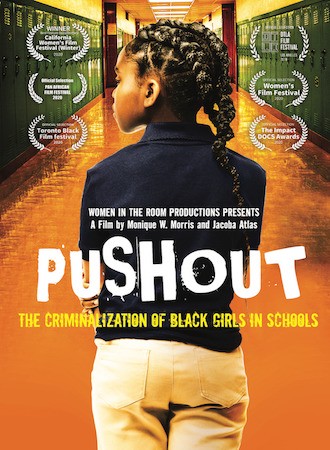
Pushout: The Criminalization of Black Girls in School 2019
Distributed by The Video Project, 145 - 9th St., Suite 102, San Francisco, CA 94103; 800-475-2638
Produced by Monique W. Morris, Jacoba Atlas, Denise Pines, and Lia Dosik Carne
Directed by Jacoba Atlas
Streaming, 79 mins
High School - General Adult
African Americans; Education; Women's Rights
Date Entered: 06/11/2020
Reviewed by Brendan Johnson, Outreach and Engagement Librarian, Penn State AbingtonThis documentary by Monique Morris and Jacoba Atlas, which serves as an extension of Morris’ book by the same name, continues the theme of examining why Black girls are more prone to be pushed out of school and into the judicial system than their White and Latina peers. The movie spotlights several Black girls, age 12-19, who describe the struggles they faced (and continue to face), and overcame, from as early as the 2nd grade. Through these girls’ experiences, Morris and Atlas attempt to provide a portrait of their daily lives and highlight the many obstacles they face, sometimes just to get to school. How the film uses the girls’ stories as they navigate the education system, and the struggles they face within it, is both heartbreaking and revealing and, at the end, hopeful.
Pushout is structured around the profiles of the girls with some narration and regular commentary from scholars and community leaders, which provide the historical, psychological and sociological context to the girls’ experiences. Each profile is preceded by statistics on relevant topics such as school discipline, bullying, and the judicial system. This device helps illustrate just how prevalent these problems are, though it would have been ideal if citations were included. Using the girls’ profiles, the film effectively highlights many of the struggles that Black girls face on a daily basis, such as racism and implicit bias, poverty, bullying, body image, mental health, and others. By putting actual students in front of the camera, it is effective at creating a visceral and meaningful argument for the viewers. The film also goes out of its way to emphasize the intersectionality of the problems faced by Black girls, describing how much of the focus on underrepresented populations is given to Black boys or White girls. By emphasizing the unique problems facing Black girls, Morris effectively establishes them as their own population with their own specific needs.
Though the majority of the film covers the ways Black girls are held back, there is an effort to discuss strategies that can be effective at helping them achieve success. Several organizations and schools are highlighted, as are the unique strategies they use to attempt to solve the problems that Black girls face, but they do not explore those strategies beyond a surface-level overview. However, the film does advocate that simply approaching Black girls with an asset-based, instead of a deficit-based perspective, and treating them as valued members of the community and as individuals whose voices need to be listened to and respected, can make a profound impact on their lives. Choosing to end on a positive note, the film does just that by concluding with a message of love and support to all the Black girls going through the same struggles. This mix of stark reality and hopeful optimism is highly recommended for collections in Sociology, Education, Gender Studies, and African American Studies for use by general audiences.
Awards:
DTLA Film Festival, Audience Favorite; California Women's Film Festival, Best Feature Documentary